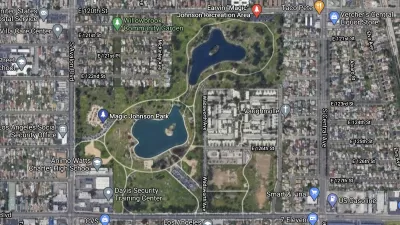The newly opened, $103 million Lick Run Greenway started as a court ordered stormwater solution. Local leaders hope it will be that and much more.

The $103 million Lick Run Greenway opened this week in Cincinnati. The park doubles as a "bio-engineered greenway," running between Queen City and Westwood avenues in South Fairmount.
According to an article by Sina Gebre-Ab and Marial Carbone, the project "began its life as a court-ordered solution to the 400 million gallons of raw sewage overflowing into Mill Creek from Cincinnati sewers each year," by diverting stormwater from sewers.
"Before this project, there was no drop of water, no drop of rain that could make its way to the creek without first getting mixed with sewage," said MSD chief operating officer Marylynn Lodor. "If you stop and think about that… every gallon that we see running through the Lick Run Greenway, that is avoided combined sewer overflows.”
Officials with the Metropolitan Sewer District attending the greenway's grand opening this week say the project has already improved conditions enough for the emergence of nine new species of fish in the creek.
South Fairmount Community Council President Jim Casey is also quoted in the article talking about the social appeal and economic development potential of the park.
“It's that community asset that finds a way to bring people together,” said South Fairmount Community Council president Jim Casey on Tuesday. “Once you have that attraction, people say, ‘Maybe there are some opportunities to build something new. Maybe there is an opportunity rehab something existing.’”
For more on the potential benefits green stormwater infrastructure, see also new research by Christopher Tirri and Mahbubur Meenar, shared by Planetizen this week.
FULL STORY: Lick Run Greenway, a $103M solution to a years-long problem, is South Fairmont 'starting again'

Planetizen Federal Action Tracker
A weekly monitor of how Trump’s orders and actions are impacting planners and planning in America.

Congressman Proposes Bill to Rename DC Metro “Trump Train”
The Make Autorail Great Again Act would withhold federal funding to the system until the Washington Metropolitan Area Transit Authority (WMATA), rebrands as the Washington Metropolitan Authority for Greater Access (WMAGA).

The Simple Legislative Tool Transforming Vacant Downtowns
In California, Michigan and Georgia, an easy win is bringing dollars — and delight — back to city centers.

The States Losing Rural Delivery Rooms at an Alarming Pace
In some states, as few as 9% of rural hospitals still deliver babies. As a result, rising pre-term births, no adequate pre-term care and "harrowing" close calls are a growing reality.

The Small South Asian Republic Going all in on EVs
Thanks to one simple policy change less than five years ago, 65% of new cars in this Himalayan country are now electric.

DC Backpedals on Bike Lane Protection, Swaps Barriers for Paint
Citing aesthetic concerns, the city is removing the concrete barriers and flexposts that once separated Arizona Avenue cyclists from motor vehicles.
Urban Design for Planners 1: Software Tools
This six-course series explores essential urban design concepts using open source software and equips planners with the tools they need to participate fully in the urban design process.
Planning for Universal Design
Learn the tools for implementing Universal Design in planning regulations.
Smith Gee Studio
City of Charlotte
City of Camden Redevelopment Agency
City of Astoria
Transportation Research & Education Center (TREC) at Portland State University
US High Speed Rail Association
City of Camden Redevelopment Agency
Municipality of Princeton (NJ)




























